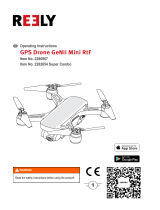
Aircraft
©
2017 DJI All Rights Reserved.
11
Aircraft
Aircraft Prole
The Mavic Pro aircraft comprises of a flight controller, video downlink, propulsion system and an
Intelligent Flight Battery. This section introduces the features of the ight controller, video downlink and
other aircraft components.
Flight Mode
The following ight modes are available for Mavic Pro:
P-mode (Positioning):
P-mode works best when the GPS signal is strong. The aircraft utilizes the GPS and
Forward and Downward Vision Systems to locate itself, automatically stabilize, and navigate between
obstacles. Advanced features such as TapFly and ActiveTrack are enabled in this mode.
When the Forward Vision System is enabled and lighting conditions are sufcient, the maximum ight
attitude angle is 16° with a maximum ight speed of 22 mph (36 kph). When forward obstacle sensing are
disabled, the maximum ight attitude angle is 25° and the maximum ight speed is 36 mph (58 kph).
The aircraft will revert to ATTI mode when GPS signal is weak, or when the compass experiences interfer-
ence where the Vision System is unavailable. In ATTI mode, the aircraft is easily affected by its surround-
ings, which may result in horizontal shifting.
In ATTI mode, the Vision System and some advanced features are disabled. Therefore, the aircraft cannot
position or auto-brake in this mode. Please land in a safe place as soon as possible to avoid hazards.
Avoid ying in areas where GPS signal is weak, or in conned spaces. The aircraft will otherwise be
forced to enter ATTI mode, leading to a potential ight hazard.
Note: P Mode requires larger stick movements to achieve high speeds.
S-mode (Sport):
The aircraft is using GPS for positioning. As Forward and Downward Vision Systems are
disabled, the aircraft will not be able to sense and avoid obstacles when in Sport Mode. Ground Station
and the Intelligent Flight functions are also not available in Sport Mode.
Note: Aircraft responses are optimized for agility and speed making it more responsive to stick
movements.
The Forward Vision System is disabled in S-mode (Sport), which means the aircraft will not
be able to automatically avoid obstacles on its route.
The aircraft’s maximum speed and braking distance are signicantly increased in S-mode
(Sport). A minimum braking distance of 30 meters is required in windless conditions.
Descending speed is signicantly increased in S-mode (Sport).
The aircraft’s responsiveness is signicantly increased in S-mode (Sport), which means a small
stick movement on the remote controller will translate into a large travel distance of the aircraft.
Be vigilant and maintain adequate maneuvering space during ight.
Use the Flight Mode switch to change the ight mode of the aircraft.























